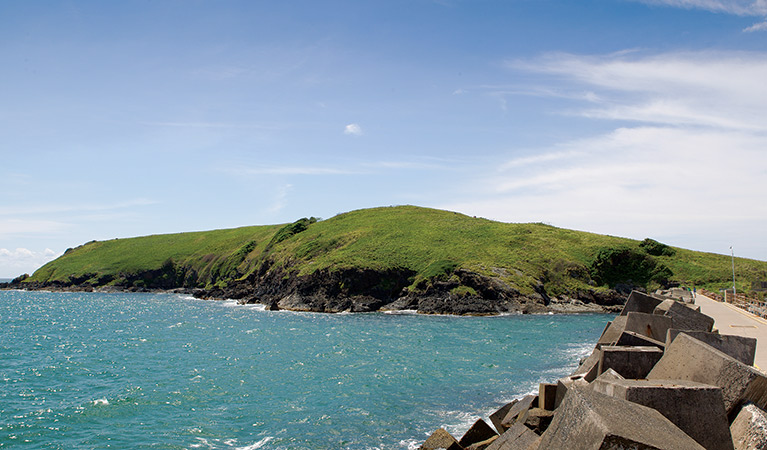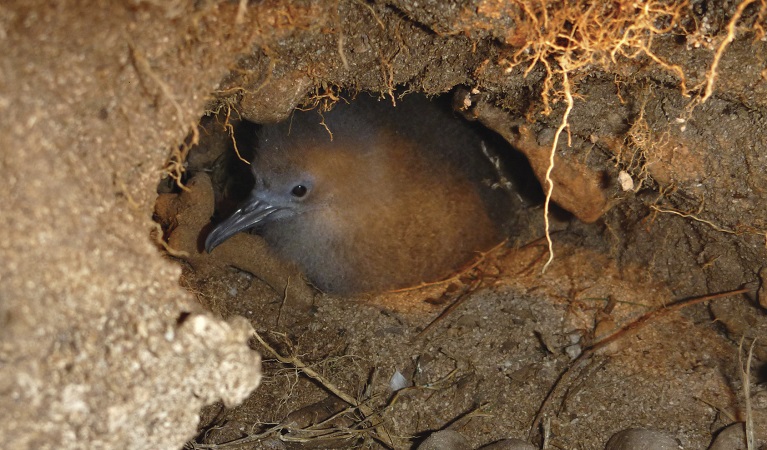Muttonbird Island Outdoor learning space
Muttonbird Island Nature Reserve
Learn more
Learn more about why this park is special
Muttonbird Island Outdoor learning space is in Muttonbird Island Nature Reserve. Here are just some of the reasons why this park is special:
Divers delight

Muttonbird Island marks the southern boundary of the Solitary Islands Marine Park. The marine park protects coral reefs, mangroves, sea-grass beds, rockpools and river estuaries. It's a diver's paradise, a place where fish species from the tropical north and temperate south mingle among the reefs.
- Eastern Side lookout The Eastern Side lookout offers spectacular views of the Solitary Islands. A short walk from the carpark, it’s a great place for whale watching in the heart of Coffs Harbour.
Giidany Miirlarl

Muttonbird Island is a sacred and significant site to the local Gumbaynggirr Aboriginal people, who call the island Giidany Miirlarl, meaning moon sacred place. The moon is the island's protector, guarding the muttonbirds as a food source and protecting them from over-harvesting. The island was also a ceremonial site. Find out more about the cultural significance of Gumbaynggirr Country, taste bush tucker foods and learn about traditional uses of plants for medicine and shelter on a guided tour with one of the Aboriginal Discovery Rangers.
Love nest

The island is home to thousands of wedge-tailed shearwaters, so called for their ability to cut or shear the water with their wings as they skim across the surface. Early settlers called them muttonbirds because of their fatty mutton-like flesh. The birds spend the Australian winter in southeast Asia, travelling back to Muttonbird Island in August each year. Amazingly, the birds return to the same burrow every year. A pair of birds share the responsibility of keeping one single egg warm and then share the raising of their chick. During the day they forage for food and return to their burrow just after dusk. They depart on their annual migration in late April every year.
- An island sanctuary self-guided audio tour Go on a self-guided audio tour with Matt Flanders across Muttonbird Island and discover the significance of this bustling seabird rookery. Take in the spectacular views as you stroll towards the easte...
- Eastern Side lookout The Eastern Side lookout offers spectacular views of the Solitary Islands. A short walk from the carpark, it’s a great place for whale watching in the heart of Coffs Harbour.
- Muttonbirds by moonlight Muttonbirds by Moonlight is an Ecosystems at risk school excursion on Muttonbird Island, a nesting rookery for wedgetail shearwaters, for Stage 6 (Years 11-12) students focusing on Geography.
- Muttonbirds by moonlight Join us at twilight for a fascinating exploration of Muttonbird Island and its nesting rookery for thousands of wedge-tailed shearwaters. This Stage 2 (Years 3-4) Geography excursion examines the feat...
- The rookery roundabout at Muttonbird Island Explore Muttonbird Island on The rookery roundabout, a Stage 1 (Years 1-2) Science and Technology excursion. Students will see an active nesting rookery for thousands of wedge-tailed shearwaters (mutt...
Plants and animals protected in this park
Animals
-

Australian pelican (Pelecanus conspicillatus)
The curious pelican is Australia’s largest flying bird and has the longest bill of any bird in the world. These Australian birds are found throughout Australian waterways and the pelican uses its throat pouch to trawl for fish. Pelicans breed all year round, congregating in large colonies on secluded beaches and islands.
Look out for...
Australian pelican
Pelecanus conspicillatus

The curious pelican is Australia’s largest flying bird and has the longest bill of any bird in the world. These Australian birds are found throughout Australian waterways and the pelican uses its throat pouch to trawl for fish. Pelicans breed all year round, congregating in large colonies on secluded beaches and islands.
Education resources (1)
School excursions (5)
- Giidany Miirlarl: A special site, Stage 3 (Years 5-6), Science and Technology
- Muttonbirds by moonlight, Stage 6 (Years 11-12), Geography
- The rookery roundabout at Muttonbird Island, Stage 1 (Years 1-2), Science and Technology
- Giidany Miirlarl: A special site, Stage 2 (Years 3-4), Geography
- Muttonbirds by moonlight, Stage 2 (Years 3-4), Geography
